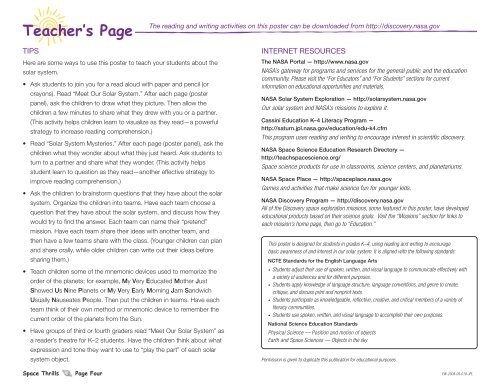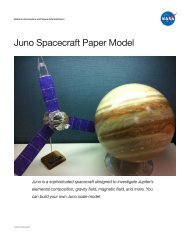meet Our Solar System - New Frontiers - NASA
meet Our Solar System - New Frontiers - NASA
meet Our Solar System - New Frontiers - NASA
Create successful ePaper yourself
Turn your PDF publications into a flip-book with our unique Google optimized e-Paper software.
Teacher’s Page<br />
Tips<br />
Here are some ways to use this poster to teach your students about the<br />
solar system.<br />
• Ask students to join you for a read aloud with paper and pencil (or<br />
crayons). Read “Meet <strong>Our</strong> <strong>Solar</strong> <strong>System</strong>.” After each page (poster<br />
panel), ask the children to draw what they picture. Then allow the<br />
children a few minutes to share what they drew with you or a partner.<br />
(This activity helps children learn to visualize as they read—a powerful<br />
strategy to increase reading comprehension.)<br />
• Read “<strong>Solar</strong> <strong>System</strong> Mysteries.” After each page (poster panel), ask the<br />
children what they wonder about what they just heard. Ask students to<br />
turn to a partner and share what they wonder. (This activity helps<br />
student learn to question as they read—another effective strategy to<br />
improve reading comprehension.)<br />
• Ask the children to brainstorm questions that they have about the solar<br />
system. Organize the children into teams. Have each team choose a<br />
question that they have about the solar system, and discuss how they<br />
would try to find the answer. Each team can name their “pretend”<br />
mission. Have each team share their ideas with another team, and<br />
then have a few teams share with the class. (Younger children can plan<br />
and share orally, while older children can write out their ideas before<br />
sharing them.)<br />
• Teach children some of the mnemonic devices used to memorize the<br />
order of the planets; for example, My Very Educated Mother Just<br />
Showed Us Nine Planets or My Very Early Morning Jam Sandwich<br />
Usually Nauseates People. Then put the children in teams. Have each<br />
team think of their own method or mnemonic device to remember the<br />
current order of the planets from the Sun.<br />
• Have groups of third or fourth graders read “Meet <strong>Our</strong> <strong>Solar</strong> <strong>System</strong>” as<br />
a reader’s theatre for K–2 students. Have the children think about what<br />
expression and tone they want to use to “play the part” of each solar<br />
system object.<br />
Space Thrills Page Four<br />
The reading and writing activities on this poster can be downloaded from http://discovery.nasa.gov<br />
iNTERNET REsouRcEs<br />
The <strong>NASA</strong> Portal — http://www.nasa.gov<br />
<strong>NASA</strong>’s gateway for programs and services for the general public and the education<br />
community. Please visit the “For Educators” and “For Students” sections for current<br />
information on educational opportunities and materials.<br />
<strong>NASA</strong> <strong>Solar</strong> <strong>System</strong> Exploration — http://solarsystem.nasa.gov<br />
<strong>Our</strong> solar system and <strong>NASA</strong>’s missions to explore it.<br />
Cassini Education K–4 Literacy Program —<br />
http://saturn.jpl.nasa.gov/education/edu-k4.cfm<br />
This program uses reading and writing to encourage interest in scientific discovery.<br />
<strong>NASA</strong> Space Science Education Research Directory —<br />
http://teachspacescience.org/<br />
Space science products for use in classrooms, science centers, and planetariums.<br />
<strong>NASA</strong> Space Place — http://spaceplace.nasa.gov<br />
Games and activities that make science fun for younger kids.<br />
<strong>NASA</strong> Discovery Program — http://discovery.nasa.gov<br />
All of the Discovery space exploration missions, some featured in this poster, have developed<br />
educational products based on their science goals. Visit the “Missions” section for links to<br />
each mission’s home page, then go to “Education.”<br />
This poster is designed for students in grades K–4, using reading and writing to encourage<br />
basic awareness of and interest in our solar system. It is aligned with the following standards:<br />
NCTE Standards for the English Language Arts<br />
• Students adjust their use of spoken, written, and visual language to communicate effectively with<br />
a variety of audiences and for different purposes.<br />
• Students apply knowledge of language structure, language conventions, and genre to create,<br />
critique, and discuss print and nonprint texts.<br />
• Students participate as knowledgeable, reflective, creative, and critical members of a variety of<br />
literacy communities.<br />
• Students use spoken, written, and visual language to accomplish their own purposes.<br />
National Science Education Standards<br />
Physical Science — Position and motion of objects<br />
Earth and Space Sciences — Objects in the sky<br />
Permission is given to duplicate this publication for educational purposes.<br />
EW-2008-09-018-JPL



